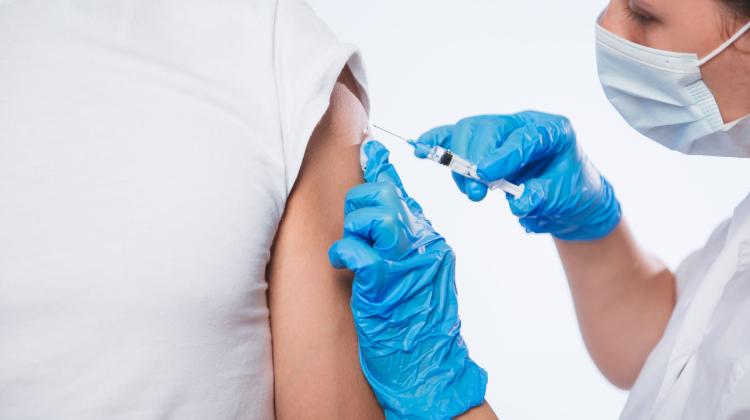‘Know your enemy’s secrets’ says virologist who compares fight against COVID-19 with a military intelligence op
 Credit: Fotolia
Credit: Fotolia
Attempts to develop vaccines for HIV or HCV have been made for decades without success. But if not for years of research on those and other viruses, work on anti-SARS-CoV-2 therapies would not be so fast, says virologist Professor Krystyna Bieńkowska-Szewczyk.
Although only a few months have passed since the outbreak of the COVID-19 epidemic, advanced clinical trials of SARS-CoV-2 vaccine are already underway in various centres around the world. Meanwhile, attempts to develop vaccines for HIV or HCV (causing hepatitis C, the discovery of which was awarded this year's Nobel Prize in Medicine and Physiology) have been going on for decades and are still unsuccessful. In an interview with PAP, virologist Professor Krystyna Bieńkowska-Szewczyk from the University of Gdańsk explains the differences in the pace of work on various vaccines against viruses. It turns out that it is not only about research funding.
The researcher notes that the work on the vaccine and drugs for SARS-CoV-2 would not have proceeded so quickly if it were not for the experience that scientists have gained in the work on therapies against other viruses - not only SARS-CoV-1, but also HCV, HIV, Ebola, influenza or hepatitis B. “Various variants of vaccine design have been tried on other viruses. Thanks to this, we know which solutions are more likely to work in the case of SARS-CoV-2,” says the virologist.
VACCINE TYPES
The researcher lists the most important ingredients of currently available vaccines:
* weakened, attenuated virus (e.g. one of the first polio vaccines developed in the 1950s by Hilary Koprowski);
* killed, inactivated virus (e.g. tick-borne encephalitis vaccine);
* virus-like particles that do not contain the genetic material of the virus (e.g. papillomavirus HPV vaccine, which also prevents the development of cervical cancer);
* viral fragments purified of the natural virus (e.g. influenza vaccine);
* virus fragments obtained in vitro, for example in yeast (e.g. hepatitis B vaccine);
* vector-borne virus fragments, i.e. viruses harmless to the host (e.g. Ebola vaccine).
PROGRESS OF WORK ON SARS-CoV-2 VACCINES
When it comes to SARS-CoV-2, says Bieńkowska-Szewczyk, in Oxford, phase 3 clinical trials are currently underway on the last type of vaccine, a vector vaccine. It is based on non-pathogenic adenovirus variants, to which proteins characteristic of SARS-CoV-2 have been attached. Adenoviruses are common viruses that cause symptoms of colds in humans, so the body recognizes them easily and could eliminate them quickly, so the vaccine uses it as so-called rare vectors, variants of these viruses or similar animal adenoviruses. The Russians have a similar idea for a vaccine (using adenoviruses), but their vaccine has not been tested in accordance with the applicable rules of clinical trials.
Advanced work carried out in the US and Germany also concerns a vaccine based on mRNA - a piece of genetic information intended to help the host produce an antigen protein to fight SARS-CoV-2. Bieńkowska-Szewczyk says: “This is an experimental variant. Such a vaccine has never been used before, although there has been a lot of work on the use of mRNA in anti-cancer vaccines. Although its safety has been shown in preliminary studies, many more tests are needed to confirm its effectiveness.” She points out that when it comes to mass production for the whole world, such a vaccine would be much easier to produce than other types.
China, in turn, conducts phase 3 clinical trials on a vaccine with inactivated viruses.
EBOLA - FAST BUT ON A SMALL SCALE
Speaking about the history of vaccination against viruses, the virologist says that the greatest success so far in terms of the pace of work has been the work on the Ebola vaccine (based on VSV viruses that cause stomatitis in cattle). Although this hemorrhagic fever has been known in Africa for a long time, the pace of vaccine development gained momentum only after its outbreaks spread to Europe and the US. “It was the only vaccine that was developed in just over two years,” she says.
But this vaccine was not planned for mass use. “It is used to extinguish the outbreak. People contacted by the sick are vaccinated, and then - their contacts,” Bieńkowska-Szewczyk says. Therefore, vaccinations do not cover the entire population, but only people around the outbreaks. Thanks to this approach, it is possible to keep up with the production of vaccines.
Ebola is a serious disease and it is impossible to overlook any of its outbreaks. SARS-COV-2 is different, in many patients the infection is asymptomatic, which makes it difficult to identify all carriers of the disease. Therefore, vaccines are needed for virtually the entire human population. “Never before has a vaccine been prepared so fast on such a scale. And it is the scale of vaccination production that will be the greatest challenge,” Bieńkowska-Szewczyk says.
NO SUCCESS IN THE SEARCH FOR HCV VACCINE
In the case of Ebola, the vector vaccine based on other viruses worked well. But this approach had been tested before in the HIV and HCV vaccine trial, unfortunately without success. The virologist says her team was involved in the development of an adenovirus-based HCV vector vaccine. “This vaccine is virtually non-existent. The work was completed in 2019, and the degree of protection provided by this vaccine was too low to be considered a success,” she says. But she adds that, for example, based on the knowledge gained from this research, a team from Oxford is now working on a similar vaccine for SARS-COV-2.
Bieńkowska-Szewczyk explains that HCV mutates very quickly. “While in the case of SARS-CoV-2, we have had similar viral strains all over the world for six months, in the case of HCV, a huge number of variants, which differ significantly from each other - we call them pseudo-species -. appear in just one day It is like trying to hit a whole cloud of objects with a stone,” she says.
HIV AND THE GREAT THAI TRIAL FAILURE
Previous research on the HIV vaccine was also a great failure, despite the fact that huge funds were spent (including grants from the Bill Gates Foundation). The so-called Thai trial - a third phase clinical trial - was conducted in 2003 on over 10,000 Thai soldiers and citizens. Half of the people were given the test preparation, and the other half - a placebo. “The study lasted five years, and the infection rate differences between the groups ranged from a dozen to 30 percent. This is not enough to introduce the vaccine to the market,” the professor says.
She adds that in the case of HIV - as in the case of HCV - the problem is the rapid mutation rate of the virus. Another important issue is that HIV multiplies in cells of the immune system - T lymphocytes. “To fight the virus, the system attacked by this virus is stimulated with a vaccine. This system has to fight itself. This is a big obstacle,” she adds.
In the case of SARS-CoV-2 it is easier, because this virus primarily affects the respiratory system.
NO VACCINE, BUT IT CAN BE TREATED
The virologist points out that although there is no vaccine for HCV and HIV yet, effective drugs against these viruses are already available (vaccines, administered preventively, 'teach' the body what the virus looks like and prepare for future fight against it, and drugs - used temporarily - inhibit the disease or its symptoms).
For HIV, there are drugs that are effective enough to prevent AIDS from developing and give people a normal life, although they never completely eliminate the virus from the body. For several years, drugs have also been available that can quickly remove HCV. The work of this year's Nobel laureates in the field of medicine were crucial for their development. Bieńkowska-Szewczyk says that although these drugs are effective, they are still very expensive, and therefore unavailable to millions of patients, for example in India or China. “That is why one of the discoverers of HCV, Nobel laureate Michael Houghton, whom I met at many virology conferences, is still working on an HCV vaccine.
“The work of today's Nobel Prize winners is not only the isolation and identification of the hepatitis C virus, but also (the work of Alter and Houghton) contributing to stopping thousands of viral infections by stopping the use of blood from paid donors in clinics (in the past, blood was obtained in this way for transfusion and one infected donor could infect entire blood banks). More than 30 years of work with Charles Rice's laboratory has made a huge contribution to understanding HCV, one of the most difficult to 'crack' viruses, which, until recently, could not be grown in a laboratory and whose only host is human,” she adds.
Bieńkowska-Szewczyk continues: “The development of drugs for viral diseases caused by HIV and HCV would not be possible if the molecular biology of pathogens had not been understood,”
As a result, it was possible to find substances that block the action of proteins that viruses need to multiply. The professor says: “It is a success if a compound is found that inhibits pathogen enzymes, but does not damage processes in human cells.” She points out that if we want to find a cure for COVID-19, we need to understand the biology of SARS-Cov-2 very well: know how the pathogen multiplies, how it interacts with its host. “We have to find the weak points of the virus and hit them without damaging the cell in which the pathogen is located,” she says, comparing the work of molecular biologists to the work of military intelligence. “Just like in the military, it is important to know the enemy's secrets, so the search for new therapeutic methods must be based on the study of the biology of the virus,” she says.
PAP - Science in Poland, Ludwika Tomala
lt/ zan/ kap/
tr. RL
Przed dodaniem komentarza prosimy o zapoznanie z Regulaminem forum serwisu Nauka w Polsce.



















